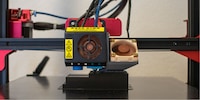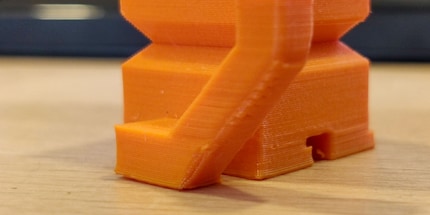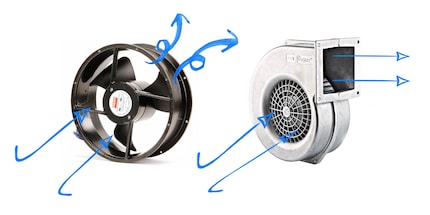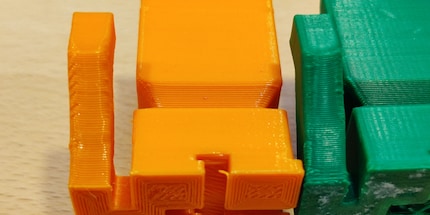
Background information
From 55 to 42 dB: 3D printer fan upgrade
by Kevin Hofer

After replacing all the fans on my Creality CR-10S Pro 3D printer, it no longer works as it should. An odyssey of troubleshooting begins, which ends with important insights into the printing behaviour of PLA and a lesson in axial vs. radial fans.
Some time ago, I replaced all five stock fans in my CR-10S Pro with Noctua fans. The result: wonderfully quiet 42 dB sound compared to the 55 dB before the conversion.
A short time after the conversion, however, frustration sets in: some of my PLA 3D prints just don't want to work the way I want them to. After a lot of troubleshooting, I finally discovered the problem: it was the filament fan. I actually know the rule: "If something no longer works as it did before, undo the last thing you changed." This could have saved me a lot of time. But I'm too ambitious.
After converting the CR-10S Pro, I printed exclusively with PETG for a few weeks. This filament behaves differently to PLA. Higher printing temperatures are required, but less cooling is needed. Printing works perfectly with this material, which is why I don't notice that anything is wrong. Then I want to start my PLA comparison test.
In the process, I come across an unforeseen problem: the PLA deforms when it overhangs, bending upwards at the edges. In contrast to warping, as I know it, it pulls through the entire print, but only with overhangs.

As I find out, the phenomenon is related to cooling. It occurs when the PLA that is being extruded is not cooled fast enough, but PLA that has already been applied is cooled too much. The layers that have already been applied contract during cooling. This deforms the material being extruded because it does not cool down quickly enough.
How can this happen in my case? It has to do with the fan, which I have replaced. The Noctua NF-A4x10 PMW is an axial fan. Previously, a radial fan was installed as a filament cooler. Although axial fans transport relatively large volumes of air with minimal effort, they swirl the air when they discharge it on the other side and generate less static pressure than radial fans. Centrifugal fans, on the other hand, can control the air flow better and therefore generate more static pressure. Two properties that are central to a filament cooler. However, the radial fans generate more noise, which is why I changed the fan.

I actually know what's causing the problem now. But I don't want to admit it. After all, my printer works almost as quietly as a whisper with the new fans. The filament fan made the most noise and I definitely don't want to replace it. It's too nice when the 3D printer no longer makes me feel like I'm constantly working next to the airport.
I'll try it another way. Maybe it's because of my fan bracket that the Noctua isn't cooling efficiently enough? I also redesigned it when I rebuilt the printer. I tried various designs that I found on Thingiverse and the like. Unfortunately, none of them are any good.
I try alternative slicer settings, such as those recommended by Youtuber Chad Hellebuyck.
Chad recommends setting the printing time of a layer to a minimum. This gives the filament enough time to cool down before the next layer is applied. But that doesn't help much. My PLA prints still deform during the overhangs and printing small models takes disproportionately longer. Thanks to Chad's tips, it's a little better, but good is different.

Finally, I get a slightly taller Noctua fan, the Noctua NF-A4x20 PWM. It generates slightly more static pressure due to its thicker chassis. But that doesn't help either: my PLA prints are still deforming.
After weeks of fiddling and repressing, I finally face the truth: I order a new stock radial fan for my CR-10S Pro. Lo and behold, the PLA no longer deforms. I can even run the fan at just 80 per cent of its power without the material curling. At 47 dB, my printer is now louder, but at least it works again.
User anxodia pointed out to me in the article I wrote about the fan conversion that others are having problems with the Noctua fan:

I said no at the time. I apologise for that. In this case, function is more important than convenience - or to put it another way: Radial goes over axial here.
From big data to big brother, Cyborgs to Sci-Fi. All aspects of technology and society fascinate me.
Interesting facts about products, behind-the-scenes looks at manufacturers and deep-dives on interesting people.
Show all